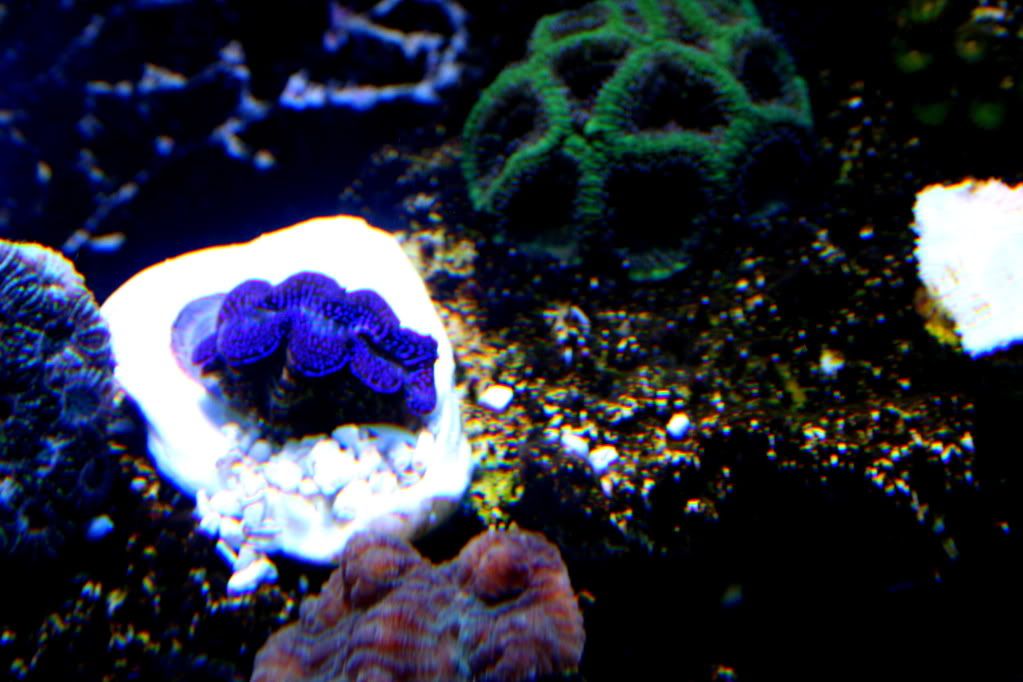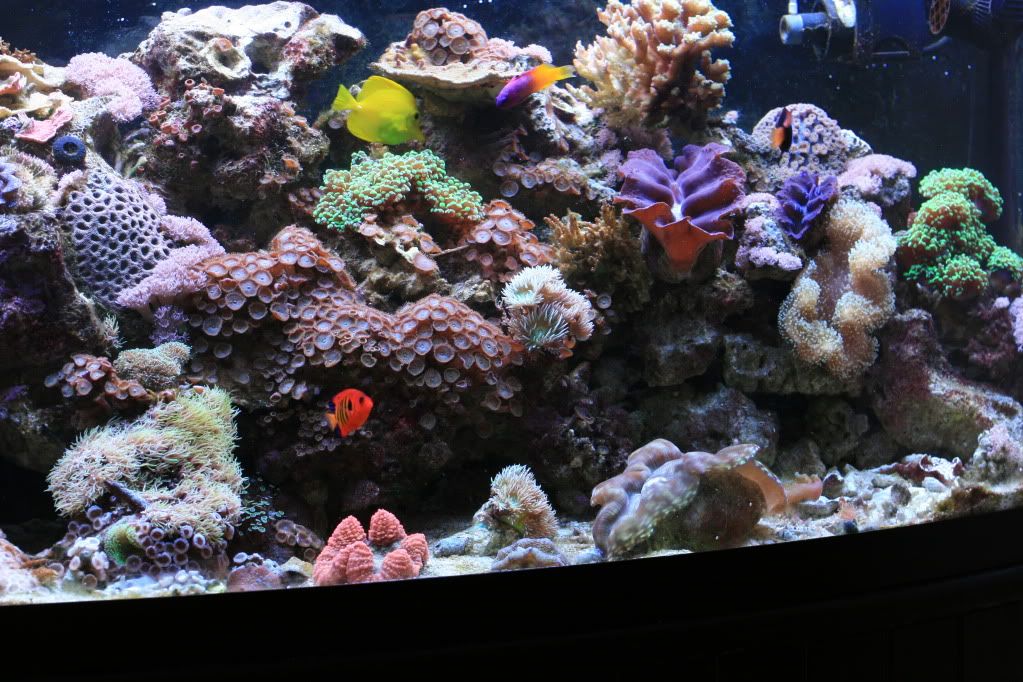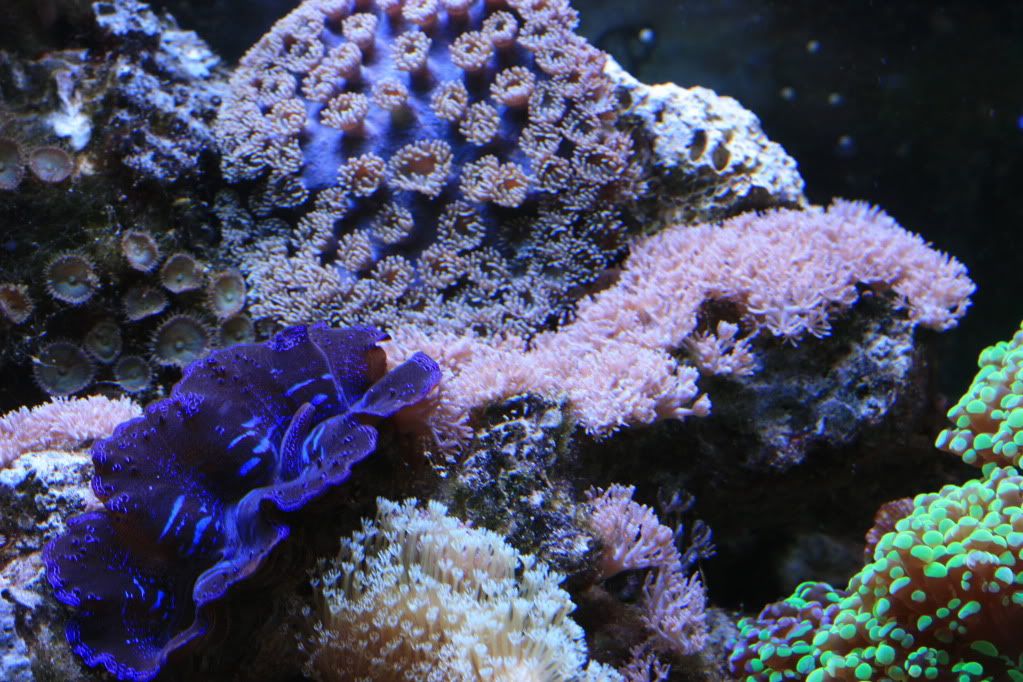crocea clam
- Thread starter evanjah
- Start date
S
saxman
Guest
hopefully you have either MH or lots of T-5 lighting, as this is by far the most light-hungry clam we keep in the hobby.
try to sit it higher up in the rockwork so it gets plenty of light, not to mention that this clam is a rock-dweller in the ocean. a good way to do this is to sit it in a clam halfshell or a small, flat piece of LR and let it attach, then you can move it easily if need be. sometimes it helps to sit the rock just under the substrate surface and let the clam 'hunker down" and attach, then you can move it.
it's large enuff to subsist by its zooxanthellae, but if you feed it a couple of times a week, it will do better, IMHO.
clams are very picky about swings in water chemistry, especially pH. a mature tank (>6 mos old) is best for them. they also don't appreciate super warm temps (above 80*F).
altho it's a bit late, you might want to remove the clam and inspect it with a mag. glass for Pyramidellae (smal white snails about the size of a rice grain). pay particular attention to the byssal area. also look for gelatinous egg sacs. if you fins any, remove them with a soft toothbrush.
HTH
try to sit it higher up in the rockwork so it gets plenty of light, not to mention that this clam is a rock-dweller in the ocean. a good way to do this is to sit it in a clam halfshell or a small, flat piece of LR and let it attach, then you can move it easily if need be. sometimes it helps to sit the rock just under the substrate surface and let the clam 'hunker down" and attach, then you can move it.
it's large enuff to subsist by its zooxanthellae, but if you feed it a couple of times a week, it will do better, IMHO.
clams are very picky about swings in water chemistry, especially pH. a mature tank (>6 mos old) is best for them. they also don't appreciate super warm temps (above 80*F).
altho it's a bit late, you might want to remove the clam and inspect it with a mag. glass for Pyramidellae (smal white snails about the size of a rice grain). pay particular attention to the byssal area. also look for gelatinous egg sacs. if you fins any, remove them with a soft toothbrush.
HTH
nycbob
Active Member
very sensitive clam. must place high up unless u hv super strong mh. dontlike too much flow. 3-inch crocea is a good size, since it gorws to only 6-8 inches max. feeding it isnt necessary if u hv plenty of fish inside the tank. clams can feed off fish waste just fine. i dont feed my 2 crocea at all, and they r growing nicely. one is already at max size, the other i got when it was 1.5 inches, and now at 3. calcium level should be around 350-450.
kirqleffna
New Member
candycane
Active Member
NYCBob here has to be the luckiest person I've met when it comes to keeping Crocea clams. How are those monsters doing anyways Bob? I don't think that Croceas should be kept in tanks at all, period. I have seen some live for 2-4 years, but I have just been doing this for WAY to long and seen WAY to many issues with Croceas and their high light demands.
nycbob
Active Member
i still hv my 2 croceas plus 2 derasa clams and maxima clams. i replaced my fixture to ati sunpower 5 weeks ago. my clams r growing and thriving, even after the tank crash i had 2 weeks ago. why do u still think t5 isnt good? there r so many people keeping clams and sps under t5 in the reef central forum, and their tanks r awesome.
candycane
Active Member
The technical answer it pretty long, so here is a short version.
You know the little things on a most Tridacnas that look pimples? On the mantle? Eyes - or whatever. Iridocytes are made up of Iridosomal Platelets that form what is called the Iridophores and along with the hyaline make up the eye, blah blah blah. These Iridophore areas are ususally surrounded by smaller shiney areas called schemochromes which push light into these areas (like mini-solar reflectors). Under these areas are patches of Zooxanthalae. The Zooxanthelae is usually most prominant around these areas because the Iridosomal Platelets basically intensify light to feed the Zooxanthelae. In a Crocea, the Zooxanthellae track is basically the most complicated "wiring" I have ever seen, far more intense then any other clam; there's a lot of it and it's pretty narrow. The best example I can give is, in a Crocea it looks like a trees' root system. In a Squamosa, IMO, it looks like a straw, LOL.
NOW, on Croceas, I have seen these little pimples go from about NOTHING to a half an inch long inside of 2 years under anything besides WICKED powerful metal halide lighting. Why would a certain clam grow these light collection-direction areas much larger and longer (the eyes, not the schemochromes)? It's the same reason a plant will stretch towards the light. It is looking to gather more light.
The schemochromes usually begin to shrink and a Crocea will tend to turn "blackish-gray" where it was once colorful as the Crocea gets larger under anything besides, well, sunlight really. As far as I know, black absorbs light easier then lighter colors. I have NEVER seen a Crocea that was in a tank under T5s for 3+ years that had anywhere near it's amount of coloration that it did when it was smaller. Squamosas, Derasas, Gigas, even some Maximas, will most of the time grow and occasionally even become more colorful with time. But I have NEVER, not ONCE, EVER seen a Crocea that still had the "reflective" qualities of it's mantle (coloration) after 3-4 years under T5 lighting, NEVER, EVER - it could probably be enough T5 lighting to be seen from the moon. Do you have any pictures of a Crocea that has been in a tank for 3-4 years that isn't "blackish-gray" with still a slight amount of "chrome" coloration? Like it still has the majority of it's "younger day" coloration? Cause it would be nice to see. The ones that I see after 3-4 years under T5 lighting, are nearly all blackish-gray with still some green or blue "shiney" spots
Here's one of the more important parts. A Croceas basic "DNA" is made up of a certain CLADE of Zooxanthellae. Mostly A but sometimes cetain Cs. Similar to most SPS corals. BECAUSE this Zooxanthellae is this specific CLADE, it HAS TO have a certain variation of PAR radiation in order to survive.
Here's part of the reason why. The difference falls in the fact that because of the many more iridophores or platelets there-of, the MAA mycosporine-glycine that is housed inside the Croceas mantle, spends most of it's time absorbing certain UV light in order to create "sunscreens" to block out others. They can usually co-exist, but sometimes one can dominate the other if one is getting more of the food source that it is supposed to have. If there is not enough UV for MAAs to use, then the clam usually starts sucking in Iodine, and COULD cause the MAAs to perish.
Now onto the final reasoning behind Croceas and their light qualities. EVERYTHING has a pigment for a reason (as far as I know) this includes zooxanthellae. zooxanthellae may be a species of algae that produces amino-acids, sugars, blah blah blah for it's host, but that wouldn't explain why the zooxanthellae is brown.
Xanthophylls are the carotenoid pigments (brown) inside the zooxanthellae that that protect it from "over exposure" from certain types of UV radiation (and even spectrums of light from what I have seen lately- I could be wrong). If the xanthophylls that reside within the zooxanthellae are not doing their job, and keep in mind they are probably 20x more densely populated in Croceas which have a higher need for light, then what will most likely happen? Same thing that happens if I have an algae outbreak in my aquarium and shut my lights off for a week.
Long story short, a crocea slowly turning blackish-gray all the way around the entire mantle - I would almost refer to as a form of "bleaching" only not white. LOL. I know it sounds odd, but it's kind of the best way I can explain it. I have been seeing some sort of Croceas lately that are just ODD though with their coloration and their lighting requirements seem a lot less intense. I can't recall the name of them right now though.
You know the little things on a most Tridacnas that look pimples? On the mantle? Eyes - or whatever. Iridocytes are made up of Iridosomal Platelets that form what is called the Iridophores and along with the hyaline make up the eye, blah blah blah. These Iridophore areas are ususally surrounded by smaller shiney areas called schemochromes which push light into these areas (like mini-solar reflectors). Under these areas are patches of Zooxanthalae. The Zooxanthelae is usually most prominant around these areas because the Iridosomal Platelets basically intensify light to feed the Zooxanthelae. In a Crocea, the Zooxanthellae track is basically the most complicated "wiring" I have ever seen, far more intense then any other clam; there's a lot of it and it's pretty narrow. The best example I can give is, in a Crocea it looks like a trees' root system. In a Squamosa, IMO, it looks like a straw, LOL.
NOW, on Croceas, I have seen these little pimples go from about NOTHING to a half an inch long inside of 2 years under anything besides WICKED powerful metal halide lighting. Why would a certain clam grow these light collection-direction areas much larger and longer (the eyes, not the schemochromes)? It's the same reason a plant will stretch towards the light. It is looking to gather more light.
The schemochromes usually begin to shrink and a Crocea will tend to turn "blackish-gray" where it was once colorful as the Crocea gets larger under anything besides, well, sunlight really. As far as I know, black absorbs light easier then lighter colors. I have NEVER seen a Crocea that was in a tank under T5s for 3+ years that had anywhere near it's amount of coloration that it did when it was smaller. Squamosas, Derasas, Gigas, even some Maximas, will most of the time grow and occasionally even become more colorful with time. But I have NEVER, not ONCE, EVER seen a Crocea that still had the "reflective" qualities of it's mantle (coloration) after 3-4 years under T5 lighting, NEVER, EVER - it could probably be enough T5 lighting to be seen from the moon. Do you have any pictures of a Crocea that has been in a tank for 3-4 years that isn't "blackish-gray" with still a slight amount of "chrome" coloration? Like it still has the majority of it's "younger day" coloration? Cause it would be nice to see. The ones that I see after 3-4 years under T5 lighting, are nearly all blackish-gray with still some green or blue "shiney" spots
Here's one of the more important parts. A Croceas basic "DNA" is made up of a certain CLADE of Zooxanthellae. Mostly A but sometimes cetain Cs. Similar to most SPS corals. BECAUSE this Zooxanthellae is this specific CLADE, it HAS TO have a certain variation of PAR radiation in order to survive.
Here's part of the reason why. The difference falls in the fact that because of the many more iridophores or platelets there-of, the MAA mycosporine-glycine that is housed inside the Croceas mantle, spends most of it's time absorbing certain UV light in order to create "sunscreens" to block out others. They can usually co-exist, but sometimes one can dominate the other if one is getting more of the food source that it is supposed to have. If there is not enough UV for MAAs to use, then the clam usually starts sucking in Iodine, and COULD cause the MAAs to perish.
Now onto the final reasoning behind Croceas and their light qualities. EVERYTHING has a pigment for a reason (as far as I know) this includes zooxanthellae. zooxanthellae may be a species of algae that produces amino-acids, sugars, blah blah blah for it's host, but that wouldn't explain why the zooxanthellae is brown.
Xanthophylls are the carotenoid pigments (brown) inside the zooxanthellae that that protect it from "over exposure" from certain types of UV radiation (and even spectrums of light from what I have seen lately- I could be wrong). If the xanthophylls that reside within the zooxanthellae are not doing their job, and keep in mind they are probably 20x more densely populated in Croceas which have a higher need for light, then what will most likely happen? Same thing that happens if I have an algae outbreak in my aquarium and shut my lights off for a week.
Long story short, a crocea slowly turning blackish-gray all the way around the entire mantle - I would almost refer to as a form of "bleaching" only not white. LOL. I know it sounds odd, but it's kind of the best way I can explain it. I have been seeing some sort of Croceas lately that are just ODD though with their coloration and their lighting requirements seem a lot less intense. I can't recall the name of them right now though.
florida joe
Well-Known Member
As Saxman said a good way to put your clam in a high light location is using a shell here I have my newly acquired maxima on a oyster shell. One thing I have found is if I use some cc on the shell the clam seems to say put much easier

BTW NYCBOB nice RG


BTW NYCBOB nice RG




